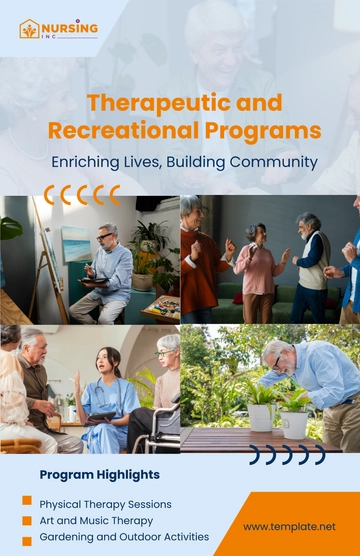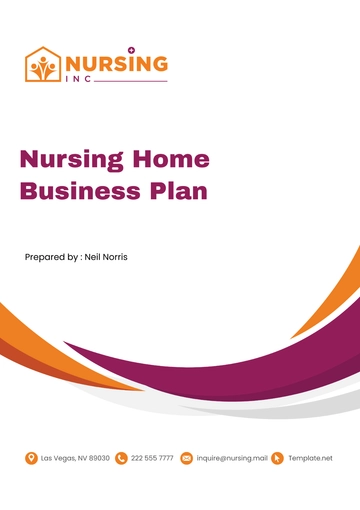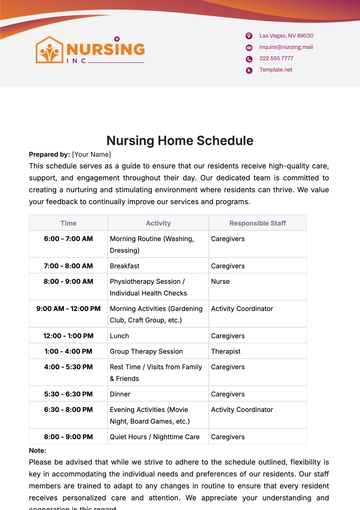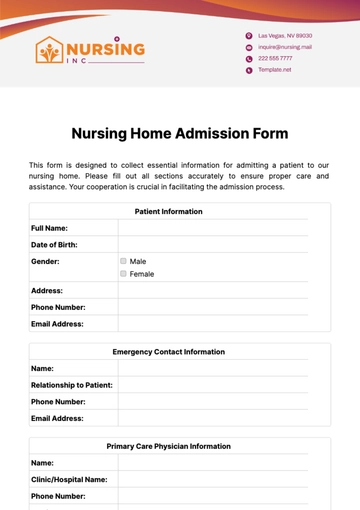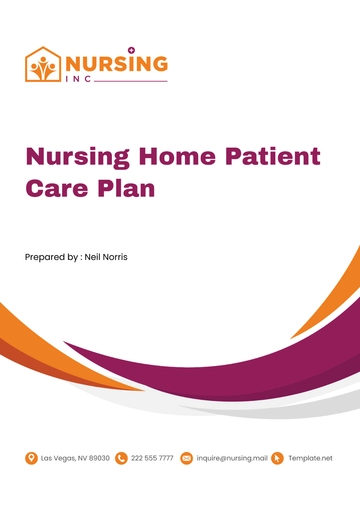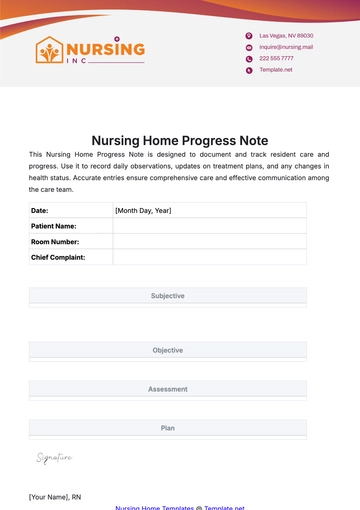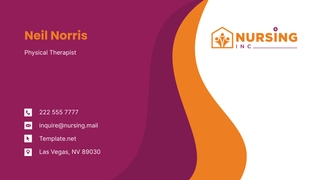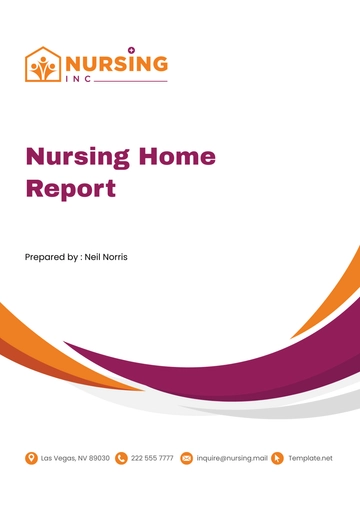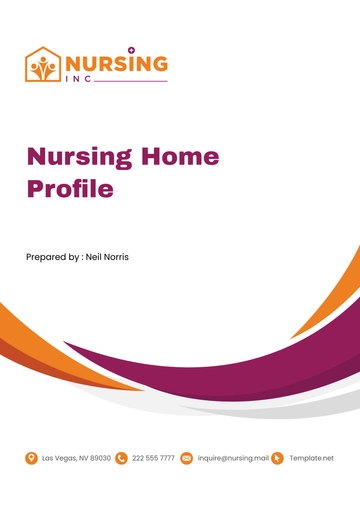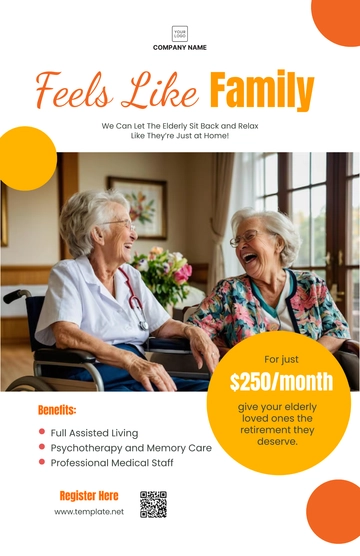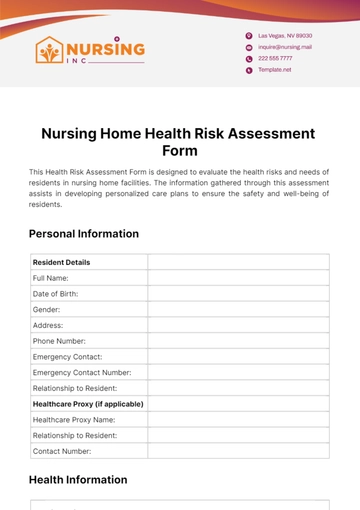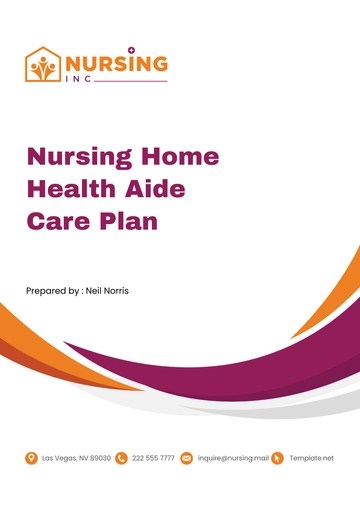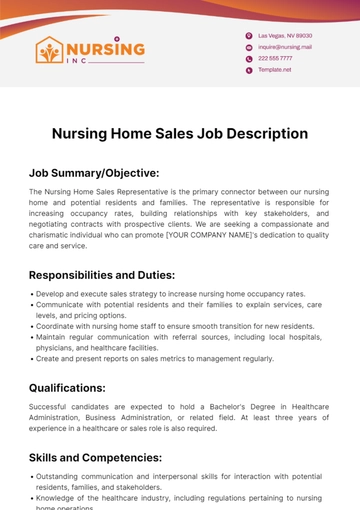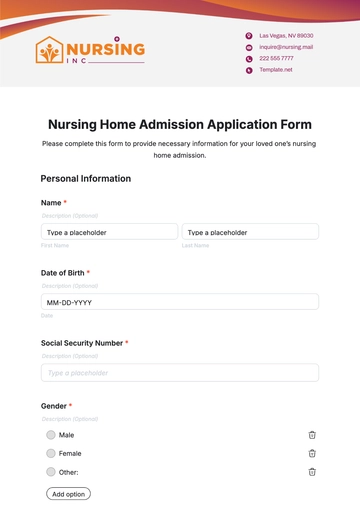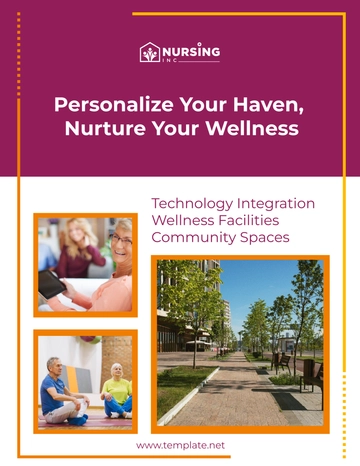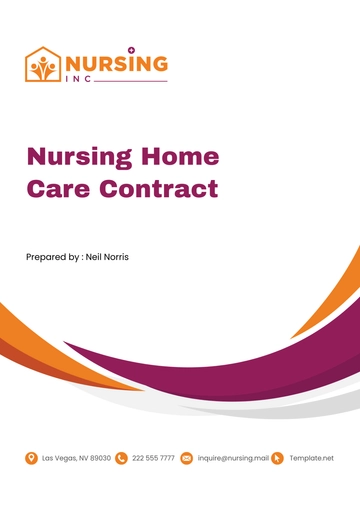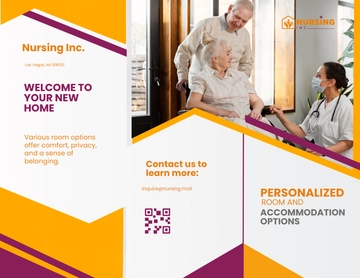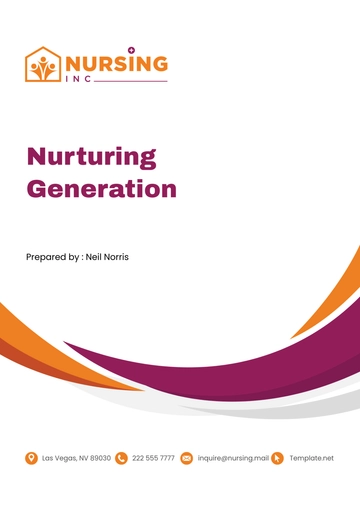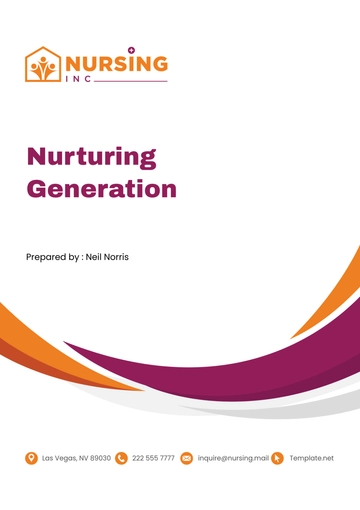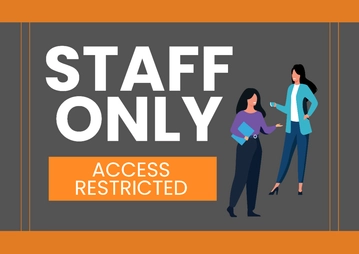Free Nursing Home Staff Feasibility Study
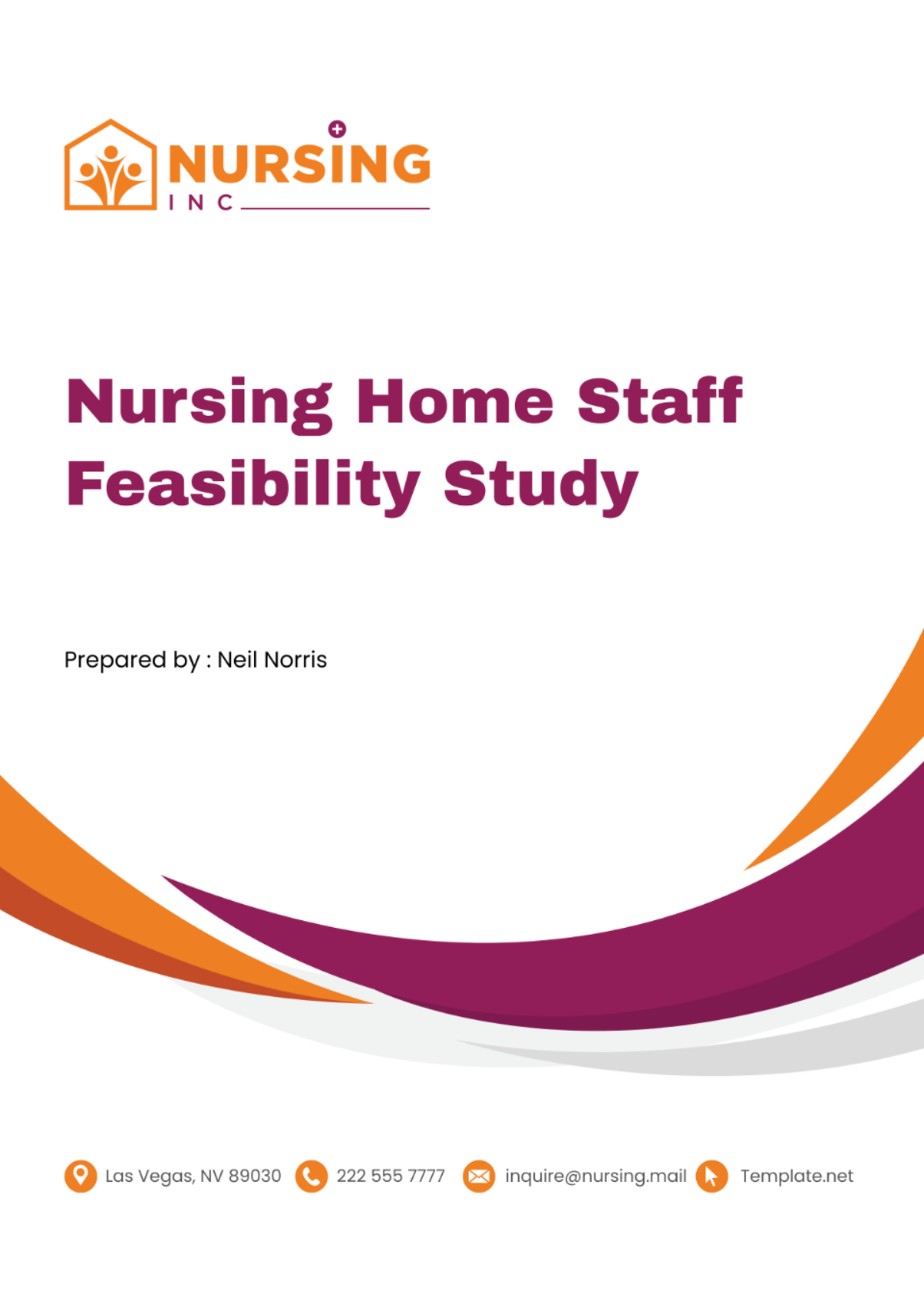
1. Project Description
In our endeavor to address the growing demand for quality elderly care, [Your Company Name] has embarked on a comprehensive Nursing Home Staff Feasibility Study. This pivotal assessment aims to ensure that our staffing model aligns with the increasing needs of our residents, guaranteeing a high standard of care and operational excellence. By scrutinizing current and projected demands, evaluating staff qualifications against resident requirements, and analyzing the financial impact of staffing options, we are poised to enhance our service delivery significantly.
The first phase of our study delves into the assessment of current and projected demand for nursing home services. With an aging population and evolving healthcare needs, it's imperative for [Your Company Name] to understand the trends and demographics shaping demand. This involves analyzing local and national data on aging populations, healthcare advancements, and societal shifts towards nursing home care. We aim to identify the scale of services needed in the forthcoming years, enabling us to tailor our facilities, services, and staffing to meet these demands effectively.
Subsequently, our study shifts focus to the evaluation of our staff structure, qualifications, and the existing ratios to resident needs. A thorough review of our current staffing model is undertaken, comparing it against best practices and regulatory standards in elderly care. We assess the qualifications, training, and competencies of our existing workforce, identifying gaps and opportunities for development. This evaluation also extends to the examination of staff-to-resident ratios, ensuring that our staffing levels are optimized for delivering personalized, high-quality care.
Finally, we explore the financial implications of various potential staffing strategies. This analysis is twofold: it considers the cost efficiency of different staffing models and evaluates their impact on the quality of care provided. We model several scenarios, including the integration of advanced care technologies, staff retraining programs, and adjustments in staff composition. By forecasting the costs and benefits associated with each strategy, [Your Company Name] aims to find a sustainable staffing solution that not only meets our financial criteria but also elevates the standard of care for our residents.
Through this comprehensive Nursing Home Staff Feasibility Study, [Your Company Name] is dedicated to setting a new benchmark in elderly care, ensuring that our residents receive the utmost attention, compassion, and professionalism.
2. Market Analysis
As [Your Company Name] navigates the evolving landscape of elderly care, our Market Analysis provides a critical examination of demographic shifts and burgeoning trends within the industry. This analysis not only sheds light on the anticipated increase in the elderly population but also explores the escalating demand for innovative technological solutions in nursing care. By staying abreast of these changes, we aim to adapt and thrive in a competitive market.
A. Demographic Shifts
Our in-depth analysis of demographic shifts focuses on statistical forecasts and social trends affecting the elderly population. We scrutinize data related to life expectancy, birth rates, and migration patterns, which collectively contribute to a growing demographic requiring specialized nursing care. This evaluation aids in understanding the scale of demand and planning for the expansion of services and facilities to accommodate the increasing number of elderly residents.
Demographic Factor | Current Statistics | Projected Statistics ([Year]) | Impact Analysis |
|---|---|---|---|
Life Expectancy | 79 years | 84 years | Increased demand for long-term care services as the population ages. |
Birth Rates | 12 births per 1,000 population | 9 births per 1,000 population | Decreasing young population may lead to a smaller workforce available for elderly care. |
Migration Patterns | Net migration of 500,000 per year | Net migration of 600,000 per year | Potential for increased diversity in elderly care needs and preferences. |
Elderly Population (65+) | 50 million (15% of population) | 80 million (20% of population) | Significant increase in the target demographic for nursing home services. |
B. Technological Advancements in Care
Simultaneously, we explore the burgeoning trend towards incorporating technology into elderly care. This includes telemedicine, wearable health monitors, and AI-driven care management systems that promise to enhance the quality of life for residents while optimizing staff efficiency. By considering these technological innovations, [Your Company Name] positions itself at the forefront of modern nursing care, ready to meet future demands with cutting-edge solutions.
Technology | Current Usage | Projected Development ([Year]) | Benefits |
|---|---|---|---|
Telemedicine | Utilized in 30% of nursing homes | Expected to be standard in 90% of facilities | Enhances access to specialized care, reduces the need for transportation. |
Wearable Health Monitors | 20% adoption rate among elderly residents | 70% adoption rate projected | Real-time health monitoring, early detection of potential health issues. |
AI-driven Care Management Systems | Emerging technology in 10% of homes | Anticipated to be integral in 80% of homes | Optimizes staff allocation, personalizes care plans, improves efficiency. |
Robotics in Care | Pilot programs in select facilities | Broad implementation expected | Assists with physical tasks, provides companionship, ensures 24/7 care availability. |
These tables offer a concise yet comprehensive snapshot of the critical factors and technological innovations [Your Company Name] is considering as part of our strategic planning for the future of nursing home care. By understanding demographic trends, we can better anticipate the needs of our future residents and plan for the necessary expansion of services and facilities. Simultaneously, staying abreast of technological advancements enables us to enhance the quality of life for our residents and improve operational efficiencies, positioning [Your Company Name] as a leader in modern, technologically advanced nursing care.
3. Legal Considerations
Within the complex and regulated environment of elderly care, [Your Company Name] undertakes a rigorous analysis of the legal framework that shapes our operations. This segment of our feasibility study scrutinizes the regulatory mandates regarding nursing home staff qualifications and the standards of care we are obligated to meet. Furthermore, we anticipate and evaluate the potential implications of future legal changes within the industry, ensuring our readiness and compliance in a landscape that is both dynamic and demanding.
A. Regulatory Compliance on Staffing and Care
Central to our legal considerations is a thorough review of the existing regulatory requirements that dictate staff qualifications and the overarching standards of resident care. This analysis covers a broad spectrum, from the accreditation of healthcare professionals to the adherence to established ratios of care providers to residents. By aligning with these stringent regulatory frameworks, [Your Company Name] not only meets but strives to exceed the industry benchmarks for quality care. Our commitment to regulatory compliance underpins our dedication to delivering care that is both compassionate and professional, maintaining the dignity and wellbeing of our residents at the forefront of our operations.
Regulatory Area | Requirement | Current Compliance Status | Action Plan for Enhancement |
|---|---|---|---|
Staff Qualifications | Minimum education and certification for nursing staff. | 100% compliance with current standards. | Implement an ongoing education and certification renewal program. |
Staff-to-Resident Ratios | Specific ratios depending on care level needed. | Ratios meet current requirements. | Regularly review and adjust staffing levels to exceed minimum standards. |
Resident Care Standards | Regulations on the quality and scope of care provided. | Fully compliant with care standards. | Develop a continuous improvement program to enhance care quality. |
Healthcare Professional Accreditation | Accreditation requirements for medical and care staff. | All staff appropriately accredited. | Establish partnerships with accredited educational institutions for staff training. |
B. Anticipating Legal Changes
Acknowledging the ever-evolving legal landscape of the nursing home industry, our analysis extends to the proactive assessment of potential legislative shifts. This strategic approach involves continuous monitoring of policy developments, collaboration with legal experts specializing in healthcare law, and active participation in industry advocacy groups. Such vigilance allows [Your Company Name] to adapt our policies and practices in anticipation of future legal requirements, ensuring uninterrupted excellence in our service delivery. This forward-looking perspective not only safeguards our compliance but also reinforces our position as a proactive leader in the field of elderly care, ready to navigate the complexities of legal changes with resilience and strategic foresight.
Strategy | Description | Implementation Plan | Expected Outcome |
|---|---|---|---|
Policy Monitoring | Continuous tracking of legislative developments in healthcare and elderly care. | Set up a legal task force to monitor and report on relevant legislative changes. | Early identification of potential legal changes impacting operations. |
Legal Expertise Collaboration | Working with legal experts specializing in healthcare law. | Engage with legal consultants for quarterly reviews of compliance and strategy adjustment. | Ensure that policies and practices remain ahead of legal requirements. |
Industry Advocacy Participation | Active involvement in industry advocacy groups. | Membership in key elderly care associations and participation in policy discussions. | Influence policy development and gain insights into upcoming legislative changes. |
Training on Legal Changes | Keeping staff informed and trained on new legal requirements. | Develop a legal update training module for staff to be updated annually or as needed. | Maintain a workforce that is knowledgeable about and compliant with the latest legal requirements. |
This structured approach not only ensures that we meet the existing legal standards but also equips us to proactively adapt to changes, safeguarding our commitment to providing exceptional care and maintaining the trust of our residents and their families. Through vigilant monitoring, strategic collaborations, and continuous education, [Your Company Name] remains at the forefront of legal and regulatory compliance in the nursing home industry.
4. Operational Feasibility
Our Operational Feasibility study is pivotal in identifying and addressing any existing deficiencies within our staff structure and qualifications. This critical evaluation is foundational to ensuring that our staffing aligns seamlessly with our mission to provide unparalleled care. Moreover, we delve into the financial dimensions of bolstering our workforce through additional hiring or advanced training, aiming to strike an optimal balance between enhancing service quality and maintaining financial sustainability.
A. Identifying Staffing Gaps
At the core of our operational analysis lies the identification of gaps in our current staff structure and qualifications. By conducting a thorough assessment of our workforce, we map out areas where enhancements are needed, whether in terms of specialist skills, staff numbers, or specific qualifications. This strategic identification process not only highlights our areas for improvement but also sets the stage for targeted interventions. Through this analytical approach, [Your Company Name] ensures that every member of our team is perfectly positioned and equipped to meet the evolving needs of our residents, thereby enhancing the overall quality of care provided.
Staff Category | Current Number | Ideal Number (Based on Demand) | Gap | Specialist Skills/Qualifications Needed |
|---|---|---|---|---|
Registered Nurses | 20 | 30 | 10 | Advanced Geriatric Care, Wound Management |
Care Assistants | 40 | 50 | 10 | Dementia Care Training |
Physical Therapists | 5 | 8 | 3 | Specialization in Elderly Mobility |
Administrative Staff | 10 | 12 | 2 | Healthcare Management Systems |
This table highlights the current staffing levels against the projected needs based on demand, identifying specific gaps in numbers and qualifications. It sets the stage for strategic recruitment and training to bridge these gaps.
B. Financial Implications of Staffing Enhancements
Understanding the financial implications of staffing enhancements is crucial for ensuring the long-term sustainability of our operations. This part of our feasibility study rigorously assesses how the addition of staff or the investment in further training impacts our operational budget. We explore various scenarios, including the integration of new roles and the development of existing staff skills, to enhance our service offerings. By carefully weighing the costs against the anticipated improvements in care quality and operational efficiency, [Your Company Name] is committed to making informed decisions that support our strategic objectives while ensuring financial health.
Enhancement Type | Estimated Cost | Anticipated Benefits | ROI Period |
|---|---|---|---|
Hiring Additional Staff | $500,000 | Improved resident care, reduced staff turnover | 2 years |
Training for Existing Staff | $100,000 | Enhanced care quality, increased staff satisfaction | 1 year |
Implementing New Roles (e.g., Wellness Coordinator) | $80,000 | Improved resident wellness and satisfaction, operational efficiency | 18 months |
Technology Training for Staff | $50,000 | Improved efficiency in care delivery, better data management | 1 year |
This table outlines the financial investment required for different staffing enhancements and the expected operational and qualitative benefits, providing a clear view of the return on investment (ROI) period. By quantifying the costs and benefits, [Your Company Name] can make informed decisions on how best to allocate resources for staffing improvements.
5. Financial Feasibility
In the pivotal Financial Feasibility section of our analysis, [Your Company Name] conducts a meticulous examination of the anticipated expenses crucial for upholding and advancing our standard of care. This evaluation serves as a cornerstone for strategic planning, ensuring that our investments in recruitment, training, technology, and infrastructure are both judicious and aligned with our mission to provide exemplary care. The following table breaks down these expenses, highlighting our commitment to fiscal responsibility while fostering an environment of continuous improvement and innovation.
Expense Category | Cost (Annual) | Description/Justification |
|---|---|---|
Recruitment | $33,000 | Costs associated with hiring processes, including advertising, interviewing, and onboarding new staff to fill identified staffing gaps. |
Training and Development | $36,000 | Investment in ongoing education programs to enhance the skills and qualifications of our staff, ensuring high standards of care. |
Salary and Benefits | $500,000 | Remuneration for our dedicated staff, including competitive salaries and benefits to attract and retain top talent. |
Technology and Infrastructure | $12,000 | Expenditures on upgrading and maintaining our technological resources and physical infrastructure to support efficient and high-quality care delivery. |
6. Risks
In the strategic planning and execution phases of this project, [Your Company Name] adopts a rigorous and analytical approach to identifying and mitigating potential risks. These risks encompass unforeseen escalations in staffing costs, shifts in market demand attributed to demographic changes, and the possibility of regulatory alterations impacting our operations. By proactively addressing these variables, we aim to fortify our project against uncertainties, ensuring resilience and adaptability in our service delivery framework.
Staffing Cost Volatility
A primary concern within our risk matrix is the volatility of staffing costs. Increases in these expenses could arise from various factors, including wage inflation, scarcity of specialized skills, or changes in labor laws. This risk necessitates a continuous evaluation of our staffing model and compensation strategies, ensuring they remain both competitive and sustainable, thereby safeguarding our financial stability and operational capabilities.
Demographic Shifts and Market Demand
Another significant risk is the fluctuation in market demand driven by demographic shifts. As population dynamics evolve, so too does the demand for elderly care services. This necessitates an agile approach to strategic planning, where [Your Company Name] remains attuned to demographic trends and adjusts service offerings in anticipation of changing needs, ensuring our relevance and competitiveness in the market.
Regulatory Changes
Finally, the potential for regulatory changes poses a risk to our operational framework. Changes in healthcare policies, standards of care, or staffing regulations could necessitate substantial adjustments in our operations. To mitigate this risk, [Your Company Name] engages in proactive legal and regulatory monitoring, ensuring compliance and swift adaptation to new legislative environments. Through strategic planning and risk management, we aim to navigate these challenges effectively, maintaining our commitment to excellence in elderly care.
7. Recommendations
In response to the comprehensive analysis conducted in this feasibility study, [Your Company Name] emphasizes the necessity of proactive and strategic management to navigate the evolving landscape of nursing home services. These recommendations are crafted to ensure that our facility not only meets the increasing demand and forthcoming regulatory changes but also continues to adapt and optimize our staff structure and qualifications in alignment with resident needs. This forward-looking approach underlines our commitment to excellence and resilience in the face of industry challenges.
Proactive Management for Rising Demand
To address the anticipated increase in demand for nursing home services, it is crucial for [Your Company Name] to adopt a proactive management strategy. This involves strategic capacity planning, investment in facility expansion, and technology integration to enhance service delivery. Anticipating demand fluctuations and preparing accordingly will position us to meet our residents' needs effectively and sustainably, ensuring that quality care remains at the core of our operations.
Adapting to Regulatory Changes
Given the dynamic nature of healthcare regulations, [Your Company Name] must remain vigilant and adaptable to legislative changes. This recommendation calls for establishing a dedicated regulatory compliance team tasked with continuously monitoring legal developments and implementing necessary adjustments. Such preparedness will safeguard our operations from compliance risks and reinforce our standing as a trusted and reputable care provider in the industry.
Continuous Staff Development
Lastly, the ongoing evaluation and adaptation of our staff structure and qualifications are paramount. This involves regular training programs, professional development opportunities, and recruitment strategies focused on attracting highly skilled care professionals. By ensuring that our staff are well-equipped and qualified, [Your Company Name] upholds a high standard of care that resonates with our commitment to the well-being and satisfaction of our residents.
Through these strategic recommendations, [Your Company Name] aims to navigate the complexities of the nursing home industry with agility and foresight, ensuring our services remain not only compliant and competitive but also deeply aligned with the needs and expectations of our residents and their families.
- 100% Customizable, free editor
- Access 1 Million+ Templates, photo’s & graphics
- Download or share as a template
- Click and replace photos, graphics, text, backgrounds
- Resize, crop, AI write & more
- Access advanced editor
Discover the comprehensive Nursing Home Staff Feasibility Study Template from Template.net. This editable and customizable document is specifically designed to streamline your feasibility studies in the healthcare field. Simplify your research process with this template easily editable in our Ai Editor Tool. Its professional, user-friendly layout can significantly help decision-making processes. With our resource, you'll conduct feasibility studies with precision and confidence. Get your hands on this efficient tool today!
